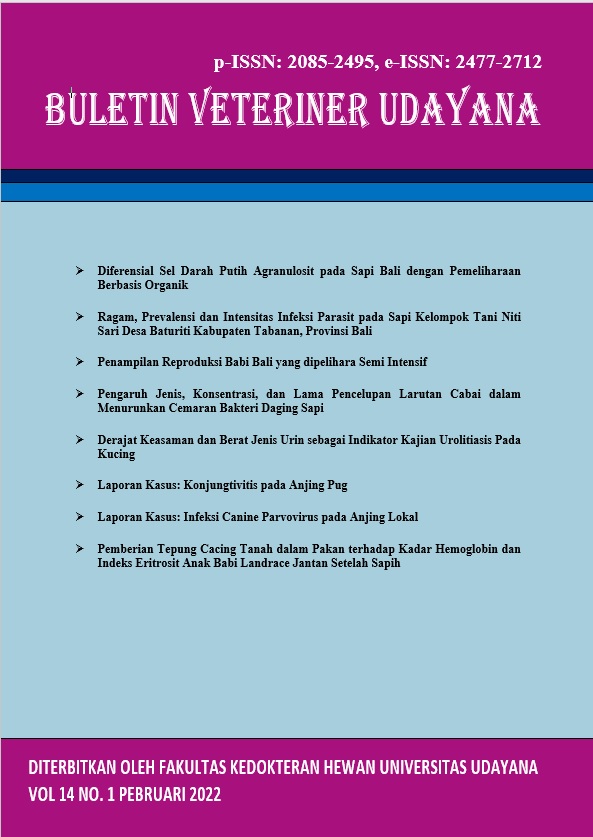CASE REPORT: CANINE PARVOVIRUS INFECTION IN LOCAL DOG
Abstract
Canine parvovirus (CPV) is a deadly infectious viral disease that causes the highest mortality in dogs, especially puppies. There are two types of canine parvovirus, namely type. The dogs examined on Friday, October 12, 2018, bear the name of Sam, local dog, male, 3 months old, weighing 2.1 kg. The dog is black and white brown. The owner of the dog is called Bapak Bagus and is addressed to Jln. Piranha II Sesetan Denpasar Selatan, Bali. Dogs have vomiting, diarrhea, have no appetite, drink, and look weak. The dogs were not vaccinated, but the parent dog was completely and systematically vaccinated. The results of the physical examination were a body temperature of 39.8 ° C, a heart rate of 172 times/minute, a pulse rate of 160 times /minute, a respiratory rate of 32 times/minute, a capillary reminder (CRT) greater than 2 seconds and pale oral mucosa. Laboratory tests in the form of negative fecal examinations and complete blood tests revealed hyperchromic microcytic anemia, leukocytosis, neutropenia, lymphocytosis, and eosinopenia, as well as a rapid test (parvovirus kit test). The treatment administered consists of a treatment consisting of the administration of a transfer factor and lactated Ringer electrolyte liquid. Amoxicillin 20 is administered with broad-spectrum antibiotics for the prevention of secondary infections. The treatment of vomiting and diarrhea is administered with perimper (hydrochloric metoclopramide) and guanistreap (kaolin-pectin)
Downloads
References
Bijanti R, Yuliani MGA, Wahyuni RS, Utomo BR. 2010. Patologi Klinik Veteriner. Airlangga University Press. Surabaya.
Decaro N, Desario C, Addie DD, Martella V, Vieira MJ, Elia G, Zicola A, Davis TG, Thiry’s C, Truyen U, Buonavoglia G. 2007. Molecular Epidemiology of Canine Parvovirus. University of Leipzig, Gemany.
Dharmawan NS. 2002. Pengantar Patologi Klinik Veteriner; Hematologi Klinik. Universitas Udayana Press. Denpasar.
Foster S. 2007. Parvovirus: Serious diarrhea in puppies and dogs. Pet Education.
Goddard A, Leisewitz AL. 2010. Canine parvovirus. Vet. Clin. North. Am. Small Anim. Pract. 40(6): 1041-1053.
Prittie J. 2004. Canine parvoviral enteritis: A review of diagnosis, management and prevention. J. Vet. Emerg. Crit. Care. 14(3): 167-176.
Sendow I, Syafriati T. 2004. Seroepidemiologi Infeksi Canine Parvovirus pada Anjing. JITV. 9(3): 181-190.
Suartha IK, Mustikawati D, Erawan IGMK, Widyastuti SK. 2011. Prevalensi penyakit parvo pada anjing di Denpasar. J. Vet. 12(3): 235-240.
Torre DDL, Mafla E, Puga B, Erazo L, Ferreira CA, Ferreira AP, 2018. Molecular characterization of canine parvovirus variants (CPV-2a, CPV-2b, CPV-2c) based on the VP2 gene in affected domestic dogs in Ecuador. Vet. World. 11(4): 480-487.
Winaya IBO, Berata IK, Adi AAAM, Kardena IM. 2014. Aspek patologis infeksi parvovirus pada anak anjing di Kota Denpasar. J. Kedokteran Hewan. 8(2): 85-89.





